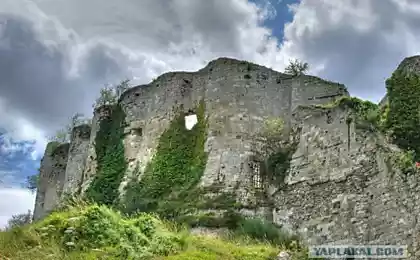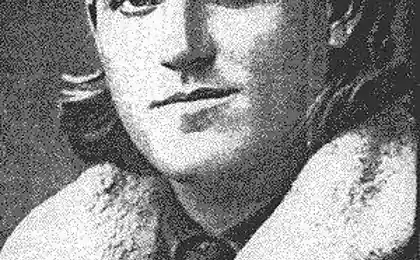2101
Retro bike (31 pics + text)
In May 2008, archaeologists from the University of Bristol, conducting excavations in the castle Château Gaillard (France), made a sensational find. At a depth of two meters was discovered a complex of iron objects, constitutes the protective armor of a warrior. Nearby, archaeologists have found the second grave, well-preserved skeleton of a horse. At the excavation site were also found coins Denier Tournois (frants.denier tournois - Tours denier) French type denarius minted by Philip II Augustus (1180-1223), as well as coin minting of the Duchy of Aquitaine named Richard, suggesting that the results relate to the armor the reign of Richard I of England (1189-1199 gg.).
Château Gaillard was the favorite castle of King Richard. He did not regret it nor the means nor the strength. They say that the King personally chose the site for its construction, and actively participated in the development of the project. As conceived by Richard Chateau Gaillard had to protect English possessions in the northwestern part of France, as Richard the Lionheart, being an English king, and carried the title of Duke of Normandy.
"At the chalk cliffs, its shape reminiscent of a spur at the foot of which lies the town of Petit-Andelys, stands the castle of Château Gaillard,
reigning over the whole Upper Normandy. It was in this place among obese Hay meadows forms a wide bend, and Château Gaillard, like a sentinel, looking around her expanse of water for ten leagues up and down the river. By order of King Richard the Lionheart built it in two years, bypassing the contracts and in order to face the king of France from here. Seeing his creation, built on a cliff, sparkling white fresh masonry, surrounded by a double ring of fortified walls, flashing, drain grates, loopholes, with thirteen towers and the main two-story tower, Richard said: "What a merry castle!" - Hence the name of the Chateau -Gayar (Chateau-Gaillard - »cheerful lock & quot; (fr.)) & quot; describes the so lock Maurice Druon in the" prisoner of Château Gaillard »
"My soldiers will take the castle, even if the walls are made of iron," - foretold the French King Philip II Augustus. "My soldiers will defend it even if the walls are made out of oil," - defiantly replied King Richard the Lionheart.
Ten years later, Philip II Augustus, together with other lands Norman wins Richard and his beloved krepost.S since Château Gaillard has ceased to be a military fortress, it was turned into a royal prison.
There are crammed important state criminals. Besides, for someone removed the drawbridge Château Gaillard, never destined to see the white light. & Quot; In 1314, the castle serves as a place of imprisonment of two daughters of the French king Philip IV the Fair, Marguerite and Blanche. During the Hundred Years War the castle Gaillard was subjected to repeated sieges. In 1417 it passed into the hands of the British after shestnadtsatimesyachnoy siege. Companion of Jeanne D Arc captures it in 1429. But in 1430, the fortress once again came under the rule of the British. In 1449 Charles VII winner returns to his possession. At the end of the last siege of Henry of Navarre was a royal decree ordered the destruction of the fortifications. Believers Andelisa "kapusiny" in 1603 and "Penitente" in 1610, obtained permission for the destruction of the castle. The collapse of the wall had stopped in 1611, when "kapusiny" felt that they already ruined walls to cover the demand for stone.
In 1852, the ruins of the castle Gaillard were recognized historical monument of France. Multiple archaeological excavations were carried out in the area from 1885 to 2000. In 2008, scientists from the University of Bristol, led by Professor John Williams, a doctor of archeology, was able to negotiate with the French government on the resumption of the excavation and, apparently, not in vain. The found burial was unique and attracted the attention of specialists from different countries: archaeologists, historians and even engineers.
Unusually in this discovery scientists it seemed very location of fragments of iron armor. From above they looked like the outline of a bicycle.
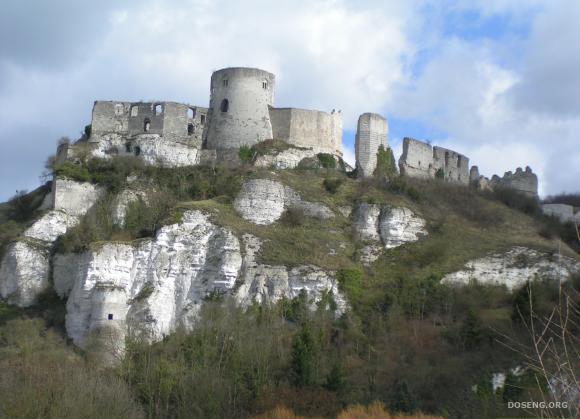
What was the surprise of archaeologists, when carefully managed to clear the fragments extracted from the centuries-old layers of soil and see more. No doubt, it was a part lain in the ground for almost nine centuries knight bike!
"-It Is really very unusual find - the head of the expedition, a professor at Bristol University John Williams - a bicycle in the twelfth century, it is hard to believe, but during excavations of burial doubts about the authenticity we did not have.
The well-preserved fragments of metal, soon managed to explain. Spectral analysis of the samples showed the presence of remnants of candle wax. Apparently, before the burial of the ancient surface of the bike has been treated molten wax, which is not allowed to destroy the metal corrosion process. Speaking of the metal.
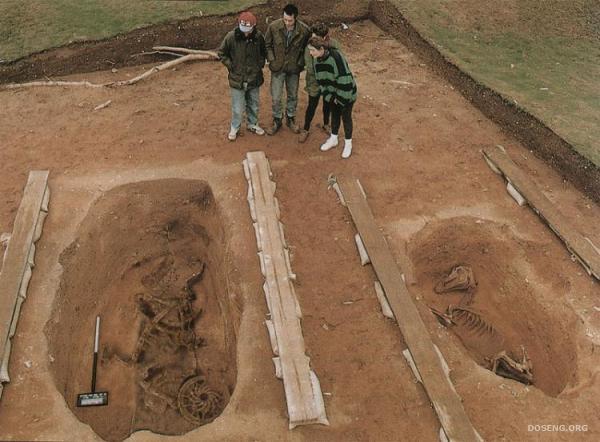
What was the surprise of archaeologists, when carefully managed to clear the fragments extracted from the centuries-old layers of soil and see more. No doubt, it was a part lain in the ground for almost nine centuries knight bike!
"- This is a really unusual find - the head of the expedition, a professor at Bristol University John Williams - a bicycle in the twelfth century, it is hard to believe, but during excavations of burial doubts about the authenticity we did not have.
The well-preserved fragments of metal, soon managed to explain. Spectral analysis of the samples showed the presence of remnants of candle wax. Apparently, before the burial of the ancient surface of the bike has been treated molten wax, which is not allowed to destroy the metal corrosion process. Speaking of the metal.
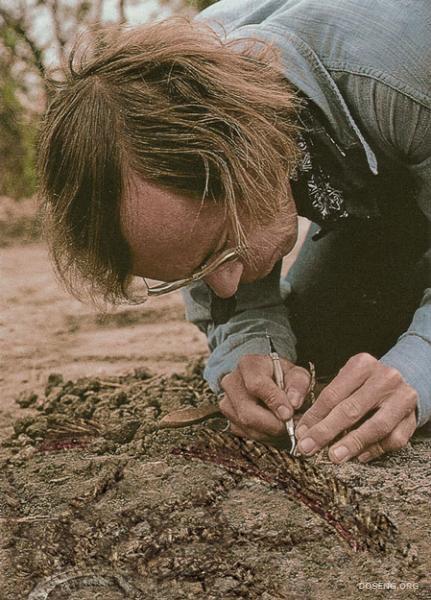
Back in Hallstatt in Europe were the basic skills of plastic processing iron, rare attempts to produce steel blades by carburizing and hardening iron. In the subsequent La Tene era it has been completely mastered the technology of manufacturing steel, including fairly sophisticated methods of producing welded parts with high quality surfaces resistant to abrasion.
Metallographic study of iron parts and the method of microscopic examination of thin sections allow us to say with confidence that the main parts of this extraordinary medieval bicycle is made of steel. As you can see, recipes for steel products with virtually no major changes have been through Roman times and had some impact on the level of blacksmith early medieval Europe. »
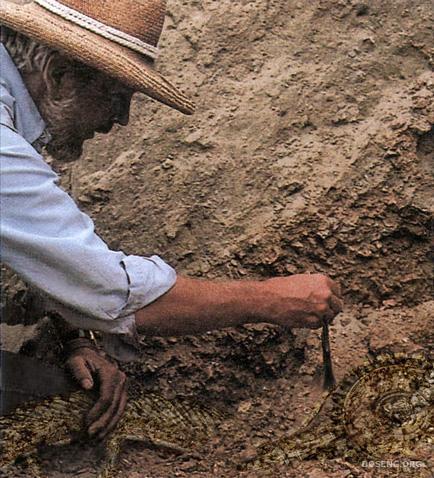

Gradually, the scientists were able to reconstruct the appearance of unusual in the era of the Knights of the vehicle. Helped engineers designers Steve Berkeley and Andrew Hopkins arrived at the excavation of the Scientific and Technical Center at the University of Cambridge.
"When they called me and said that the excavation presumably the twelfth century found the design similar to a bicycle, I cried - incredible! - Says Steve - If not for the expedition leader, John Williams, whom I know very well, thought it would be an April Fool's joke. However, the fact remains - in the Château Gaillard really rare find "ancestor" of the modern bicycle. Helping archaeologists removing piece by piece, we are trying to place Andrew in the drawing and imagine the appearance and general construction sites bicycle as everything it could to spin and work. Frankly, we are gradually imbued with admiration and respect to the medieval inventor, invented and implemented in those times so complex technical project.
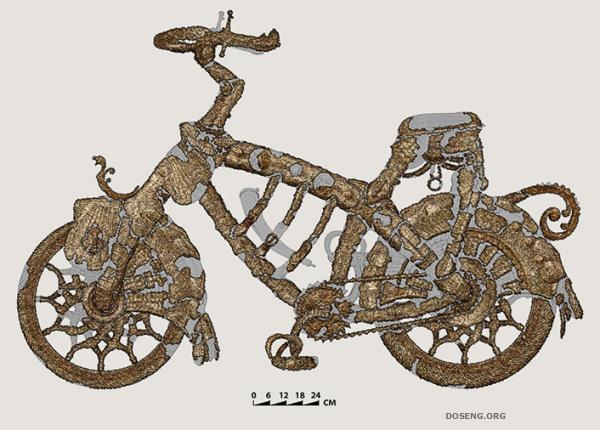
It is also interesting to understand the technology of manufacturing of each element of the Knight sipeda.
The frame is as easy as possible and has a cloisonne structure like an airplane wing: steel bars running along the frame attached to the cross-fired plates. Outside the frame is sheathed elements of knight's armor, particularly useful bracers (Bracer) and Shoulders (Pauldron) stapled together round rivets. The front fork and rear part of the frame - one-piece and trimmed outside (Greav) greaves. Stem himself steering handles are made of swords. Parts of the blades of swords (apparently degraded on the battlefields) were used as hard profiles to enhance structural strength. The seat is secured using eight forged metal arches, which served as a kind of shock absorber while driving. The decoration used saddle leather and fabric, the remains of which were found during excavations.
The frame as the water tanks was fixed horn with metal lid.

Special attention deserve the wheel of this wonderful bike. To reduce vibration during the movement, to the metal rim wound horsehair, then wrapped in circumferential bands of rough skin, and only then in a wheel mounted massive engraved pattern iron spokes, and the outside rim trimmed with metal plates, which can move relative to each other during travel. Wheels reliably protected "enclosures-wings" made of pieces cuirasses and plate gloves.
How could move this "two-wheeled crew»?
Says Andrew Hopkins:
- The excavation found two metal disc with sharp teeth at the edges. One disc was excavated in the area of the rear wheel. The second disc is found near the bottom of the frame, attached to it with the handle of the sword (probably an ancient prototype of a rod) with metal parts in sight reminiscent of a pedal. Between the discs found the remains of a chain with decorative plates. We can assume that we are faced with the first model of the transmission mechanism of chain transfer, applied in medieval Europe. While the chain drive is known to people long ago, he used the first Heron mechanisms for moving the scenery in the Athenian theater. Still amazing how medieval craftsmen were able to implement such a mechanism in the metal in the twelfth century.
But the twelfth century there is?
According to scientists, on this account, divided.
- Coins could get to the excavation site by accident, during excavation, - the archeology professor Justin Pierre, representative of the French Academy of Sciences, who participated in the excavations at the Chateau Gayar.- I, as an expert on the Knight's armament, I believe that part of the breastplate (Cuirass) , bracers (Bracer), Plate Gloves (Gauntlet) and gauntlets (Mitten Gauntlet), which were used in the manufacture of this is certainly an outstanding discoveries date back to the second half of the fifteenth century, but it does not have the twelfth and Italian origin. In some parts of the armor found the school mark of master Milanese armor of Missaglia dynasty. And most importantly: X-ray structure analysis of metal fragments breastplate revealed a structure almost identical to the Milanese armor made in the same period of time. & Quot;
Here is a quote from the handbook of knightly armament:
«Milanese armour -« Milanese armor. " Italian full armor of the XV century, a contemporary Gothic armor, differs from it in a more rounded shape and less grooved details. Mainly produced in Milan and Venice »
Scientists argue about the details of the discovery, but none of them calls into question the most sensational discoveries.
From the bike to the Middle Ages?
To answer this question, arrived at the site known worldwide specialist in the history of the bicycle, Dr. Peter Godward (Pieter Godward) from the Faculty of History and Archeology of the University of Cardiff.
& quot; Cycling - more ancient invention of human civilization than we think. - Says Peter Godward - A sensational discovery in Château Gaillard confirms the results of years of research scientists of our university. Back in 1962, the world had spread the news of the discovery of a unique French archaeologists on the territory of Versailles. Then, during the excavation, allowed the Government of France, in one of the wells was detected side gallery, which led to a vast dungeon of the palace, where among other things was found a bicycle. Cyclists soon received the name of "Sun King" in honor of King Louis XIV.
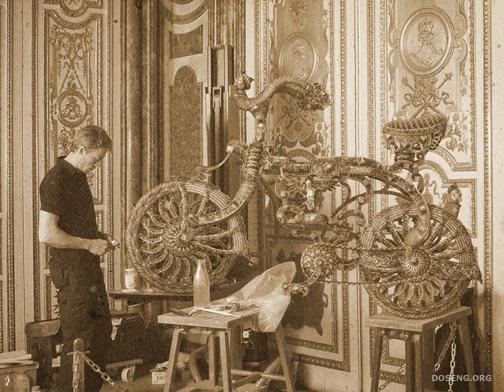
While the unexpected discovery has caused a lot of controversy among archaeologists and historians, many considered it a forgery.
The discussions came up to our university. Then in 1962, having familiarized with the materials of the excavations at Versailles, we have decided to engage seriously in "cycling" of the matter. And even created an international research center dedicated to this issue, which brought together like-minded scientists from several leading universities in the world. Over the years, we collected the information in the files, communicating with collectors, they participated in archaeological and ethnographic expeditions, studied historical documents, works of art and literature. Much time is spent in the reserves and funds of the largest museums in the world. And everywhere we wanted one - a bicycle.
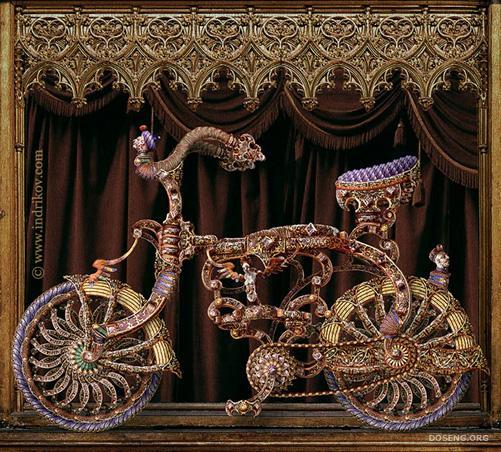
In 1986, we were called representative of the world-famous art collector, co-founder of the auction house «Sotbyes», Andrea Kastillesa.
Mr. Kastilles last road racing cyclist, member of Giro d'Italia (ital.Giro d`Italia) and 1951. "Tour de France» (Tour de France) in 1955, turned out to be a passionate collector of everything that is connected with the bike. He kindly invited us to visit, promising to show something amazing.
What we saw exceeded our wildest fantasies.
We all know the famous Italian painter Sandro Botticelli (1445-1510gg.), Author of many masterpieces, including "Spring" (1478g.) And "Birth of Venus" (1484-1486gg.). From 1492 CE to c 1500. Botticelli paintings create a grand cycle of illustrations to the "Divine Comedy" by Dante. Figures made metal pins on large sheets of parchment. Almost all of them circled in pen. Each song is dedicated to a single drawing. A few figures to the "Paradise" is not finished, and to HHH1 song "Purgatory" Master performed two variants of the drawing. One of the two figures in the collection Andrea Kastillesa.
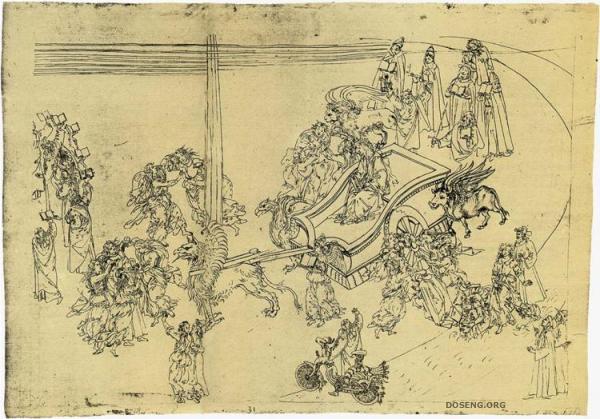
In this illustration, describing an apocalyptic vision on the sides of the sacred tuple driven seven angels, we see biblical animals: the eagle, the winged bull, winged lion and angelic man with a book. The wagon drawn by a griffin sitting Beatrice.
"Dvukolaya, between four beasts
Winning wagon stood,
And harnessed Griffin walked in front of her. »
(Dante's "Divine Comedy," "Purgatory" ch.XXXI)
- Pay attention to the figure of a man in the bottom of the illustration, welcomes the process - explains Mr. Kastilles - that you see next to him? This is - a bicycle!
Shaken, we bent over the yellowed parchment and began to carefully look into the picture.
Meanwhile, in the room already is rolled on a special cart konteyner.Ego massive front wall was made of thick glass. Behind the glass, we saw a small picture, which was depicted in the color of the bike is very similar to the one we just looked at the illustration to the "Divine Comedy»
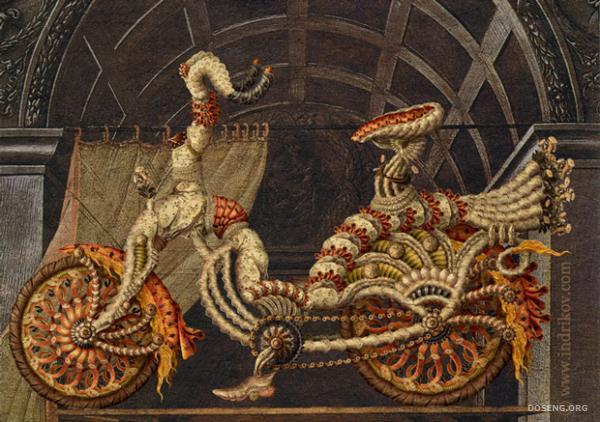
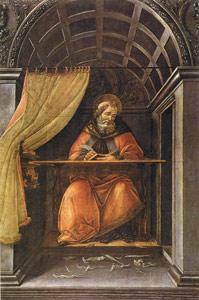
& quot; - This is a very rare work by Botticelli, - said Andrea, - yes, make no mistake, this is not fake! You, as a scientist, I would say: a comparative spectral and chemical analysis of the composition of tempera paint, soil, and even wood fibers, this and other works by Botticelli, portrait of "St. Augustine" (1495g.). The formulations are identical. By the way, the background "St. Augustine" and this picture is very similar. Apparently Botticelli created both products at the same time. The originality of this decoration, obviously, the female version of the bike can be seen due to earlier masterpieces "The Birth of Venus." Critics found that during the life of Botticelli this "portrait of a bicycle" did not find acceptance from the audience. Contemporaries apparently did not understand that there is depicted. For me as a mystery: how come Botticelli doing so the work of this unusual? Why bike explicitly for women? And where does the "Divine Comedy"? Bike Beatrice? You - the scientists, you look for answers ...
Soon after his death the painting was completely forgotten for a long time kept at the State Museum in Berlin, disappeared during the Second World War and came to me by chance, but that's another story ...
-I Have something else, follow me - Andrea Kastilles, exchanged sixth decade, respectable gentleman, an aristocrat, a sly, youthful, smiling. Apparently, the main surprise was ahead.
We followed the master, crossed the courtyard of a family castle (Kastilles Andrea, live in the family estate and is proud of its knightly roots) and climbed the stone steps to the round tower. Inside the medieval tower has undergone major reconstruction and was turned into a modern multi-tiered exhibition space with a unique lighting and thoughtful submission of each piece.
Château Gaillard was the favorite castle of King Richard. He did not regret it nor the means nor the strength. They say that the King personally chose the site for its construction, and actively participated in the development of the project. As conceived by Richard Chateau Gaillard had to protect English possessions in the northwestern part of France, as Richard the Lionheart, being an English king, and carried the title of Duke of Normandy.
"At the chalk cliffs, its shape reminiscent of a spur at the foot of which lies the town of Petit-Andelys, stands the castle of Château Gaillard,
reigning over the whole Upper Normandy. It was in this place among obese Hay meadows forms a wide bend, and Château Gaillard, like a sentinel, looking around her expanse of water for ten leagues up and down the river. By order of King Richard the Lionheart built it in two years, bypassing the contracts and in order to face the king of France from here. Seeing his creation, built on a cliff, sparkling white fresh masonry, surrounded by a double ring of fortified walls, flashing, drain grates, loopholes, with thirteen towers and the main two-story tower, Richard said: "What a merry castle!" - Hence the name of the Chateau -Gayar (Chateau-Gaillard - »cheerful lock & quot; (fr.)) & quot; describes the so lock Maurice Druon in the" prisoner of Château Gaillard »
"My soldiers will take the castle, even if the walls are made of iron," - foretold the French King Philip II Augustus. "My soldiers will defend it even if the walls are made out of oil," - defiantly replied King Richard the Lionheart.
Ten years later, Philip II Augustus, together with other lands Norman wins Richard and his beloved krepost.S since Château Gaillard has ceased to be a military fortress, it was turned into a royal prison.
There are crammed important state criminals. Besides, for someone removed the drawbridge Château Gaillard, never destined to see the white light. & Quot; In 1314, the castle serves as a place of imprisonment of two daughters of the French king Philip IV the Fair, Marguerite and Blanche. During the Hundred Years War the castle Gaillard was subjected to repeated sieges. In 1417 it passed into the hands of the British after shestnadtsatimesyachnoy siege. Companion of Jeanne D Arc captures it in 1429. But in 1430, the fortress once again came under the rule of the British. In 1449 Charles VII winner returns to his possession. At the end of the last siege of Henry of Navarre was a royal decree ordered the destruction of the fortifications. Believers Andelisa "kapusiny" in 1603 and "Penitente" in 1610, obtained permission for the destruction of the castle. The collapse of the wall had stopped in 1611, when "kapusiny" felt that they already ruined walls to cover the demand for stone.
In 1852, the ruins of the castle Gaillard were recognized historical monument of France. Multiple archaeological excavations were carried out in the area from 1885 to 2000. In 2008, scientists from the University of Bristol, led by Professor John Williams, a doctor of archeology, was able to negotiate with the French government on the resumption of the excavation and, apparently, not in vain. The found burial was unique and attracted the attention of specialists from different countries: archaeologists, historians and even engineers.
Unusually in this discovery scientists it seemed very location of fragments of iron armor. From above they looked like the outline of a bicycle.

What was the surprise of archaeologists, when carefully managed to clear the fragments extracted from the centuries-old layers of soil and see more. No doubt, it was a part lain in the ground for almost nine centuries knight bike!
"-It Is really very unusual find - the head of the expedition, a professor at Bristol University John Williams - a bicycle in the twelfth century, it is hard to believe, but during excavations of burial doubts about the authenticity we did not have.
The well-preserved fragments of metal, soon managed to explain. Spectral analysis of the samples showed the presence of remnants of candle wax. Apparently, before the burial of the ancient surface of the bike has been treated molten wax, which is not allowed to destroy the metal corrosion process. Speaking of the metal.

What was the surprise of archaeologists, when carefully managed to clear the fragments extracted from the centuries-old layers of soil and see more. No doubt, it was a part lain in the ground for almost nine centuries knight bike!
"- This is a really unusual find - the head of the expedition, a professor at Bristol University John Williams - a bicycle in the twelfth century, it is hard to believe, but during excavations of burial doubts about the authenticity we did not have.
The well-preserved fragments of metal, soon managed to explain. Spectral analysis of the samples showed the presence of remnants of candle wax. Apparently, before the burial of the ancient surface of the bike has been treated molten wax, which is not allowed to destroy the metal corrosion process. Speaking of the metal.

Back in Hallstatt in Europe were the basic skills of plastic processing iron, rare attempts to produce steel blades by carburizing and hardening iron. In the subsequent La Tene era it has been completely mastered the technology of manufacturing steel, including fairly sophisticated methods of producing welded parts with high quality surfaces resistant to abrasion.
Metallographic study of iron parts and the method of microscopic examination of thin sections allow us to say with confidence that the main parts of this extraordinary medieval bicycle is made of steel. As you can see, recipes for steel products with virtually no major changes have been through Roman times and had some impact on the level of blacksmith early medieval Europe. »


Gradually, the scientists were able to reconstruct the appearance of unusual in the era of the Knights of the vehicle. Helped engineers designers Steve Berkeley and Andrew Hopkins arrived at the excavation of the Scientific and Technical Center at the University of Cambridge.
"When they called me and said that the excavation presumably the twelfth century found the design similar to a bicycle, I cried - incredible! - Says Steve - If not for the expedition leader, John Williams, whom I know very well, thought it would be an April Fool's joke. However, the fact remains - in the Château Gaillard really rare find "ancestor" of the modern bicycle. Helping archaeologists removing piece by piece, we are trying to place Andrew in the drawing and imagine the appearance and general construction sites bicycle as everything it could to spin and work. Frankly, we are gradually imbued with admiration and respect to the medieval inventor, invented and implemented in those times so complex technical project.

It is also interesting to understand the technology of manufacturing of each element of the Knight sipeda.
The frame is as easy as possible and has a cloisonne structure like an airplane wing: steel bars running along the frame attached to the cross-fired plates. Outside the frame is sheathed elements of knight's armor, particularly useful bracers (Bracer) and Shoulders (Pauldron) stapled together round rivets. The front fork and rear part of the frame - one-piece and trimmed outside (Greav) greaves. Stem himself steering handles are made of swords. Parts of the blades of swords (apparently degraded on the battlefields) were used as hard profiles to enhance structural strength. The seat is secured using eight forged metal arches, which served as a kind of shock absorber while driving. The decoration used saddle leather and fabric, the remains of which were found during excavations.
The frame as the water tanks was fixed horn with metal lid.

Special attention deserve the wheel of this wonderful bike. To reduce vibration during the movement, to the metal rim wound horsehair, then wrapped in circumferential bands of rough skin, and only then in a wheel mounted massive engraved pattern iron spokes, and the outside rim trimmed with metal plates, which can move relative to each other during travel. Wheels reliably protected "enclosures-wings" made of pieces cuirasses and plate gloves.
How could move this "two-wheeled crew»?
Says Andrew Hopkins:
- The excavation found two metal disc with sharp teeth at the edges. One disc was excavated in the area of the rear wheel. The second disc is found near the bottom of the frame, attached to it with the handle of the sword (probably an ancient prototype of a rod) with metal parts in sight reminiscent of a pedal. Between the discs found the remains of a chain with decorative plates. We can assume that we are faced with the first model of the transmission mechanism of chain transfer, applied in medieval Europe. While the chain drive is known to people long ago, he used the first Heron mechanisms for moving the scenery in the Athenian theater. Still amazing how medieval craftsmen were able to implement such a mechanism in the metal in the twelfth century.
But the twelfth century there is?
According to scientists, on this account, divided.
- Coins could get to the excavation site by accident, during excavation, - the archeology professor Justin Pierre, representative of the French Academy of Sciences, who participated in the excavations at the Chateau Gayar.- I, as an expert on the Knight's armament, I believe that part of the breastplate (Cuirass) , bracers (Bracer), Plate Gloves (Gauntlet) and gauntlets (Mitten Gauntlet), which were used in the manufacture of this is certainly an outstanding discoveries date back to the second half of the fifteenth century, but it does not have the twelfth and Italian origin. In some parts of the armor found the school mark of master Milanese armor of Missaglia dynasty. And most importantly: X-ray structure analysis of metal fragments breastplate revealed a structure almost identical to the Milanese armor made in the same period of time. & Quot;
Here is a quote from the handbook of knightly armament:
«Milanese armour -« Milanese armor. " Italian full armor of the XV century, a contemporary Gothic armor, differs from it in a more rounded shape and less grooved details. Mainly produced in Milan and Venice »
Scientists argue about the details of the discovery, but none of them calls into question the most sensational discoveries.
From the bike to the Middle Ages?
To answer this question, arrived at the site known worldwide specialist in the history of the bicycle, Dr. Peter Godward (Pieter Godward) from the Faculty of History and Archeology of the University of Cardiff.
& quot; Cycling - more ancient invention of human civilization than we think. - Says Peter Godward - A sensational discovery in Château Gaillard confirms the results of years of research scientists of our university. Back in 1962, the world had spread the news of the discovery of a unique French archaeologists on the territory of Versailles. Then, during the excavation, allowed the Government of France, in one of the wells was detected side gallery, which led to a vast dungeon of the palace, where among other things was found a bicycle. Cyclists soon received the name of "Sun King" in honor of King Louis XIV.

While the unexpected discovery has caused a lot of controversy among archaeologists and historians, many considered it a forgery.
The discussions came up to our university. Then in 1962, having familiarized with the materials of the excavations at Versailles, we have decided to engage seriously in "cycling" of the matter. And even created an international research center dedicated to this issue, which brought together like-minded scientists from several leading universities in the world. Over the years, we collected the information in the files, communicating with collectors, they participated in archaeological and ethnographic expeditions, studied historical documents, works of art and literature. Much time is spent in the reserves and funds of the largest museums in the world. And everywhere we wanted one - a bicycle.

In 1986, we were called representative of the world-famous art collector, co-founder of the auction house «Sotbyes», Andrea Kastillesa.
Mr. Kastilles last road racing cyclist, member of Giro d'Italia (ital.Giro d`Italia) and 1951. "Tour de France» (Tour de France) in 1955, turned out to be a passionate collector of everything that is connected with the bike. He kindly invited us to visit, promising to show something amazing.
What we saw exceeded our wildest fantasies.
We all know the famous Italian painter Sandro Botticelli (1445-1510gg.), Author of many masterpieces, including "Spring" (1478g.) And "Birth of Venus" (1484-1486gg.). From 1492 CE to c 1500. Botticelli paintings create a grand cycle of illustrations to the "Divine Comedy" by Dante. Figures made metal pins on large sheets of parchment. Almost all of them circled in pen. Each song is dedicated to a single drawing. A few figures to the "Paradise" is not finished, and to HHH1 song "Purgatory" Master performed two variants of the drawing. One of the two figures in the collection Andrea Kastillesa.

In this illustration, describing an apocalyptic vision on the sides of the sacred tuple driven seven angels, we see biblical animals: the eagle, the winged bull, winged lion and angelic man with a book. The wagon drawn by a griffin sitting Beatrice.
"Dvukolaya, between four beasts
Winning wagon stood,
And harnessed Griffin walked in front of her. »
(Dante's "Divine Comedy," "Purgatory" ch.XXXI)
- Pay attention to the figure of a man in the bottom of the illustration, welcomes the process - explains Mr. Kastilles - that you see next to him? This is - a bicycle!
Shaken, we bent over the yellowed parchment and began to carefully look into the picture.
Meanwhile, in the room already is rolled on a special cart konteyner.Ego massive front wall was made of thick glass. Behind the glass, we saw a small picture, which was depicted in the color of the bike is very similar to the one we just looked at the illustration to the "Divine Comedy»


& quot; - This is a very rare work by Botticelli, - said Andrea, - yes, make no mistake, this is not fake! You, as a scientist, I would say: a comparative spectral and chemical analysis of the composition of tempera paint, soil, and even wood fibers, this and other works by Botticelli, portrait of "St. Augustine" (1495g.). The formulations are identical. By the way, the background "St. Augustine" and this picture is very similar. Apparently Botticelli created both products at the same time. The originality of this decoration, obviously, the female version of the bike can be seen due to earlier masterpieces "The Birth of Venus." Critics found that during the life of Botticelli this "portrait of a bicycle" did not find acceptance from the audience. Contemporaries apparently did not understand that there is depicted. For me as a mystery: how come Botticelli doing so the work of this unusual? Why bike explicitly for women? And where does the "Divine Comedy"? Bike Beatrice? You - the scientists, you look for answers ...
Soon after his death the painting was completely forgotten for a long time kept at the State Museum in Berlin, disappeared during the Second World War and came to me by chance, but that's another story ...
-I Have something else, follow me - Andrea Kastilles, exchanged sixth decade, respectable gentleman, an aristocrat, a sly, youthful, smiling. Apparently, the main surprise was ahead.
We followed the master, crossed the courtyard of a family castle (Kastilles Andrea, live in the family estate and is proud of its knightly roots) and climbed the stone steps to the round tower. Inside the medieval tower has undergone major reconstruction and was turned into a modern multi-tiered exhibition space with a unique lighting and thoughtful submission of each piece.


